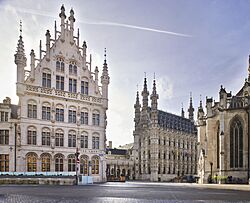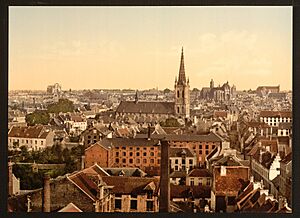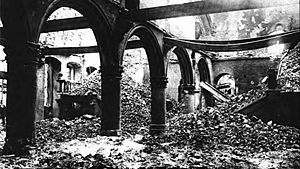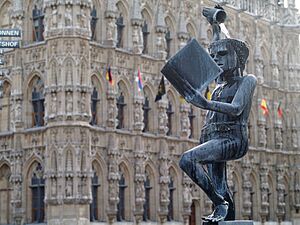Leuven facts for kids
Quick facts for kids
Leuven
|
|||
|---|---|---|---|

Leuven Town Hall in 2019
|
|||
|
|||
| Country | Belgium | ||
| Community | Flemish Community | ||
| Region | Flemish Region | ||
| Province | Flemish Brabant | ||
| Arrondissement | Leuven | ||
| Area | |||
| • Total | 56.63 km2 (21.86 sq mi) | ||
| Population
(2018-01-01)Lua error in Module:Wd at line 1575: attempt to index field 'wikibase' (a nil value).
|
|||
| • Total | Lua error in Module:Wd at line 1,575: attempt to index field 'wikibase' (a nil value). | ||
| Demonym(s) | Leuvener | ||
| Postal codes |
3000, 3001, 3010, 3012, 3018
|
||
| Area codes | 016 | ||
| Website | www.leuven.be | ||
|
|
|||
Leuven is a big city in Belgium. It is the capital of the province called Flemish Brabant. You can find Leuven about 25 kilometers (15 miles) east of Brussels, which is the capital of Belgium.
Leuven is famous for its university, KU Leuven. This university started in 1425, making it one of the oldest universities in the Low Countries (Belgium, Netherlands, Luxembourg). It is also the largest Dutch-speaking university in the world!
The city is also home to the main office of Anheuser-Busch InBev. This is the biggest beer company in the world.
Contents
- History of Leuven: A City's Journey Through Time
- Climate in Leuven: What's the Weather Like?
- Economy: How Leuven Makes Money
- People of Leuven: Demographics and Students
- Getting Around Leuven: Transport
- Culture in Leuven: Art, Music, and Beer
- Sports in Leuven: An Active City
- Buildings and Landmarks: Exploring Leuven's History and Art
- Gallery
- Famous People: Born In or Lived In Leuven
- International Connections: Twin Cities
- See also
History of Leuven: A City's Journey Through Time
How Leuven Began: Early Days
The first time Leuven was mentioned was in the year 891. This was when a Viking army was beaten by the Frankish king Arnulf of Carinthia. This event is known as the Battle of Leuven (891).
A legend says that the red and white colors on Leuven's flag show the blood-stained banks of the Dyle river after this battle.
Leuven in the Middle Ages: A Trading Hub
Leuven is located right next to the Dyle river. This made it a very important place for trade between the 11th and 14th centuries. It was a big center for making cloth.
In fact, a type of linen cloth was even called "lewyn" because it was so well-known from Leuven.
A Golden Age: The University and Art Flourish
In the 15th century, Leuven became very important again. The University of Leuven was founded in 1425. This brought a lot of smart people and new ideas to the city.
Many beautiful buildings were built then, like the Town Hall and the Saint Peter's Church. Famous painters like Dirk Bouts also lived and worked here.
Smart Thinkers and New Discoveries
By the early 1500s, Leuven was a major center for art and learning in Europe. Important thinkers like Erasmus worked here. In 1517, the Collegium Trilingue was started. It taught three old languages: Latin, Greek, and Hebrew.
This college helped people study old books and the Bible in new ways. Thomas More even published his famous book Utopia in Leuven in 1516.
Scientists like Gemma Frisius made important discoveries in mapping and astronomy. His students included Gerardus Mercator, a famous mapmaker.
Leuven in the 18th and 19th Centuries: Growth and Change
In the 18th century, a brewery called Den Horn became very successful. In 1708, Sebastien Artois became the main brewer. He later gave his name to the brewery in 1717. Today, this brewery is part of AB InBev. Their famous beer, Stella Artois, is still made in Leuven.
The city grew a lot in the 19th century. New squares were built, and streets were lit with gas lamps. Old waterways were covered, and new sewers were installed. A city theater and a main post office were also built.
Leuven in the 20th Century: World Wars and Rebuilding
World War I: A City Damaged
Leuven has been attacked and occupied many times throughout its history. In the 20th century, both World War I and World War II caused a lot of damage.
When Germany entered World War I, the city was heavily damaged. About 300 civilians died. The university library was burned down on August 25, 1914. Around 230,000 books were lost, including very old and rare manuscripts.
This destruction caused anger around the world. After the war, the old library building was rebuilt. A new main library was also built and opened in 1928.
World War II: More Destruction
In World War II, Leuven was again part of the front line. From May 14 to 16, 1940, German forces attacked the city. The new university library building was set on fire by bombs. Nearly a million books were lost this time.
Climate in Leuven: What's the Weather Like?
Leuven has a mild climate. Summers are generally warm, and winters are cool. Rain is spread throughout the year. The city gets a good amount of sunshine, especially from April to August.
| Climate data for Leuven (1991–2020) | |||||||||||||
|---|---|---|---|---|---|---|---|---|---|---|---|---|---|
| Month | Jan | Feb | Mar | Apr | May | Jun | Jul | Aug | Sep | Oct | Nov | Dec | Year |
| Mean daily maximum °C (°F) | 6.6 (43.9) |
7.7 (45.9) |
11.6 (52.9) |
15.9 (60.6) |
19.5 (67.1) |
22.3 (72.1) |
24.4 (75.9) |
24.1 (75.4) |
20.5 (68.9) |
15.6 (60.1) |
10.4 (50.7) |
7.0 (44.6) |
15.5 (59.9) |
| Daily mean °C (°F) | 3.9 (39.0) |
4.4 (39.9) |
7.2 (45.0) |
10.4 (50.7) |
14.1 (57.4) |
17.1 (62.8) |
19.2 (66.6) |
18.8 (65.8) |
15.5 (59.9) |
11.6 (52.9) |
7.4 (45.3) |
4.5 (40.1) |
11.2 (52.2) |
| Mean daily minimum °C (°F) | 1.2 (34.2) |
1.0 (33.8) |
2.8 (37.0) |
4.9 (40.8) |
8.8 (47.8) |
11.9 (53.4) |
14.0 (57.2) |
13.5 (56.3) |
10.5 (50.9) |
7.5 (45.5) |
4.3 (39.7) |
1.9 (35.4) |
6.9 (44.4) |
| Average precipitation mm (inches) | 70.4 (2.77) |
62.2 (2.45) |
54.5 (2.15) |
43.3 (1.70) |
55.5 (2.19) |
67.3 (2.65) |
72.7 (2.86) |
79.5 (3.13) |
60.5 (2.38) |
62.8 (2.47) |
68.5 (2.70) |
83.5 (3.29) |
780.7 (30.74) |
| Average precipitation days (≥ 1 mm) | 12.7 | 11.6 | 11.1 | 8.9 | 9.6 | 9.6 | 10.0 | 10.2 | 9.8 | 10.6 | 11.8 | 13.6 | 129.4 |
| Mean monthly sunshine hours | 59 | 74 | 129 | 181 | 210 | 211 | 217 | 204 | 160 | 117 | 66 | 50 | 1,678 |
| Source: KMI/IRM | |||||||||||||
Economy: How Leuven Makes Money
Leuven's economy is very strong in technology and research. This is because of the KU Leuven university, which is known for being very innovative. Many new companies have started from ideas developed at the university.
There is also a research center called IMEC in Leuven. It focuses on tiny electronics and digital technologies. This means many companies in areas like biotech and robotics are located nearby.
Major Companies and Industries
Big international companies like Siemens and Huawei have important offices in Leuven. The academic hospital UZ Leuven is also a huge research center. It is one of the biggest hospitals in Europe.
Leuven is the worldwide headquarters of Anheuser-Busch InBev, the largest beer company. Their Stella Artois brewery is a very noticeable part of the city.
Another big company based in Leuven is KBC Group. This is a major financial group in Europe. It offers banking and insurance services.
People of Leuven: Demographics and Students
As of 2016, Leuven had over 100,000 people living there. The city is made up of several smaller areas, including Leuven center, Kessel-Lo, Heverlee, Wilsele, and Wijgmaal.
Student Life in Leuven
Leuven has a very large number of students, many of whom come from other countries. The Katholieke Universiteit Leuven (KU Leuven) has more than 50,000 students. It is the oldest Catholic university still open in the world.
There are also other colleges, like the UC Leuven-Limburg (UCLL). This makes Leuven a lively and youthful city.
Getting Around Leuven: Transport
It's easy to get around Leuven. You can walk or ride a bicycle for most distances. Many streets in the city center don't allow cars, or they have very slow speed limits. This makes it safe for walking and biking.
Buses and Trains
Public buses, run by De Lijn, connect the city to nearby areas and help people travel within the city. There's even a "Ringbus" that goes around the city's main road. You can also take buses to Brussels Airport.
Leuven has a busy train station. Trains connect Leuven to major cities like Brussels and Liège. There are also important highways nearby, like the E40 and E314.
Culture in Leuven: Art, Music, and Beer
Leuven is a city rich in culture. It has a famous music school called the Lemmens Institute. This school is known for its music therapy and drama programs.
The Kunstencentrum STUK is a cultural center that hosts music, theater, and dance shows. Leuven also has a summer rock festival called Marktrock.
Museums and Art
In 2009, the M – Museum Leuven opened. It shows both old and new art. The museum has featured works by famous international and Belgian artists.
Beer Culture
Leuven is famous for its beer. It's the birthplace of beers like Stella Artois. There are many bars in Leuven that offer a huge variety of local and international beers. Some bars even claim to have over 3,000 different kinds!
Sports in Leuven: An Active City
Leuven was chosen as the European City of Sport for 2021. This was partly because it hosted the 2021 UCI Road World Championships, a big cycling event. The city also hosts other cycling races every year.
Team Sports
The main football club is Oud-Heverlee Leuven. Both their men's and women's teams play at the highest level. The city's top basketball team is the Leuven Bears.
Other popular sports teams include IHC Leuven (ice hockey) and KHC Leuven (field hockey). Leuven also has a GAA club called 'the Earls of Leuven'. This club is part of a larger European league for Irish sports.
Buildings and Landmarks: Exploring Leuven's History and Art
Secular Buildings: Non-Religious Sites
- The Town Hall is a stunning building built between 1439 and 1463. It's in a late-Gothic style. In the 19th century, 236 statues were added to its outside walls. These statues represent important people from Leuven's history.
- Arenberg Castle was built in the 16th century. It was later updated in a Neogothic style. The duke of Arenberg gave the castle to Katholieke Universiteit Leuven in 1916. It has beautiful green parks and gardens that are open to everyone.
- The University Library on the Ladeuzeplein was a gift from the American people after World War I. The original library was burned down by German forces. The library's tower has one of the largest carillons (a musical instrument with bells) in the world.
- The Oude Markt (Old Market) is a lively square in the center of Leuven. It has a statue called 'De Kotmadam' (The Landlady) sitting on a bench.
- Fonske is a statue near the city center. Its full name means "fountain of wisdom." The statue shows a student letting wisdom flow into his head from a glass. Like the Manneken Pis in Brussels, Fonske sometimes wears different costumes for special events.
Religious Buildings: Churches and Abbeys
- St. Peter's Church was built between 1425 and 1500. It has beautiful paintings from the 15th to 18th centuries, including Dirk Bouts' famous painting of the Last Supper. The church's tower was meant to be much taller but was never finished. It is now a UNESCO World Heritage Site.
- Saint-Anthony's Chapel holds the tomb of Father Damien. He was a Catholic priest who helped people with leprosy on the island of Molokai. He was made a saint in 2009.
- The Large Beguinage is a historic area with many small houses and churches. It was a community for religious women called Beguines. It is one of the best examples of its kind in the world and is a UNESCO World Heritage Site.
- Park Abbey is a large abbey founded in 1129. It is one of the best-preserved abbey complexes in the Low Countries. A small group of canons (religious priests) still live there today.
Colleges: Historic University Buildings
The Old University of Leuven used to have many colleges. Some of these are still used by KU Leuven today.
- Holy Ghost College was founded in 1442. Today, it is a home for theology students and priests.
- Collegium Trilingue was started in 1517. It taught Hebrew, Greek, and Latin. It was a model for other famous colleges in Europe.
- Pope's College was a college for theology students. It was founded by Pope Adrian VI in 1523.
- St Anthony's College was founded in 1607. It was an important center for Irish learning in Europe. Today, it houses the Leuven Institute for Ireland in Europe.
Gallery
Famous People: Born In or Lived In Leuven
People Born in Leuven
- Sennek, a singer who represented Belgium in the 2018 Eurovision Song Contest.
- Quentin Matsys, a famous painter.
- Adriaan van Roomen, a mathematician.
- Arthur De Greef, a pianist and composer.
- Mark Eyskens, a politician and former Prime Minister of Belgium.
- Kim Gevaert, an Olympic gold medalist in running.
- Dries Mertens, a famous footballer.
- Selah Sue, a musician and songwriter.
- Elise Mertens, a tennis player.
People Who Lived in Leuven
- Adrian VI, who later became a pope.
- Dirk Bouts, a painter.
- Desiderius Erasmus, a very important humanist and thinker.
- Georges Lemaître, an astronomer who suggested the Big Bang theory for how the universe began.
- Gerardus Mercator, a famous mapmaker.
- Andreas Vesalius, an anatomist and physician.
International Connections: Twin Cities
Leuven has special connections with other cities around the world. These are called "twin towns" or "sister cities."
Twin Towns/Sister Cities
 's-Hertogenbosch, Netherlands
's-Hertogenbosch, Netherlands Kraków, Poland
Kraków, Poland Lüdenscheid, Germany
Lüdenscheid, Germany Rennes, France
Rennes, France Ottignies-Louvain-la-Neuve, Belgium
Ottignies-Louvain-la-Neuve, Belgium
Friendly Relations
Leuven also has friendly connections with other cities:
Leuven has an 'adoptive village' in Romania:
See also
 In Spanish: Lovaina para niños
In Spanish: Lovaina para niños























